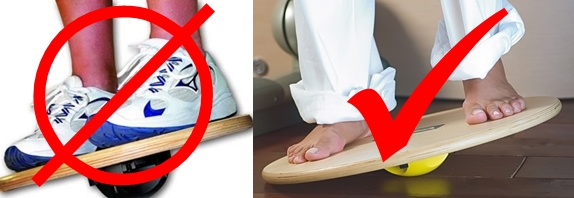In forefoot running, much of the power comes from the ankle which in turn, reduces mechanical loads on the knee. However, to get the best out of forefoot running, a runner must run barefoot or in pure minimalist shoes.
The only problem is, many minimalist and barefoot transitioners have weak ankles as a consequence of the traditional running shoe.
This is where ankle-joint stabilizing exercises comes in handy via the wobble board.
Balance Barefoot on Wobble Board
Balancing yourself on a wobble board while barefoot is a great form of proprioceptive training and restores functional motor patterns necessary for optimal balance during forefoot running.
Further, balancing on a wobble board stimulates coactivation of the plantar flexors, ankle and calf musculature. Doing so while barefoot results in advanced information that controls fast movements thereby allowing greater neuromuscular control and functional stability of the ankle joint.
Another benefit is the relative safeness of the wobble board which minimizes the risk of injury or reinjury.
Why balance barefoot on the wobble board? Because the ankle is proprioceptively under neuromuscular control. This means that ankle joint functionality is governed by 3 different levels of the central nervous system. The 3 levels are:
1. Spinal Level Reflexes: provides reflexive joint stabilization on uneven terrain.
2. Motor Control in the Brainstem: provides balance and posture of the body by receiving visual input as well as input from the joints via mechanoreceptors.
3. Cognitive Awareness: initiates voluntary movements based on cognitive or perceptual awareness of body position and movements.

Now you can begin to appreciate the importance of the ankle in running because a decrease in proprioceptive feedback from the feet, and therefore the ankle, results in abnormal body positions and poor postural reflexes.
So, if you are new to forefoot running and think that your ankles are weak, gradually learn to balance barefoot on a wobble board to avoid the hassle of developing sore ankles or ankle injury.
More From Run Forefoot:
- Treadmill Running Increases Loads on the Arch
- Some Heel Strikers Tend to NOT Heel Strike When Tired
- Shoes Effects Forefoot Strike Compared to Running Barefoot
- Running Shoes for Forefoot Runners
References:
Kennedy JC, Alexander IJ, Hayes KC Nerve supply of the human knee and its functional importance. Am J Sports Med 10 329-335, 1982
Konradsen L, Ravn JB. Ankle instability caused by prolonged peroneal reaction time Acta Orthop Scand 61 388-390, 1990
Lephart et al. The current role of proprioception in the management and rehabilitation of athletic injuries. Am J Sports Med, 1997; 25(1):130-137.
Bretta Riches
BSc Neurobiology; MSc Biomechanics candidate, ultra minimalist runner & founder of RunForefoot. I was a heel striker, always injured. I was inspired by the great Tirunesh Dibaba to try forefoot running. Now, I'm injury free. This is why I launched Run Forefoot, to advocate the health & performance benefits of forefoot running and to raise awareness on the dangers of heel striking, because the world needs to know.
Latest posts by Bretta Riches (see all)
- Are Minimalist Shoes Good for Seniors? YES! - 14/04/2024
- BIG Deals On Running Gear And More! - 09/04/2024
- Why Are My Feet Tired After Running? - 04/04/2024

online casino on lat – online casino with a withdrawal of money, official casino slot machines
resource carders forum
Discover More Here buy dumps
Configure XMRig – Скачать NiceHash Miner 20.0, XMRig 5.3.0
look at this now Trade Bitcoin on Bitniex.com
next page гидра com
websites
Expert Tradonator Nextgen Mt4
koop a-pihp – hexedrone, kup hexedrone
casino 1xslots
click here for more how to commit suicide
viagra super active en pharmacie sans ordonnance – cliquez ici maintenant, cliquez sur la page a venir